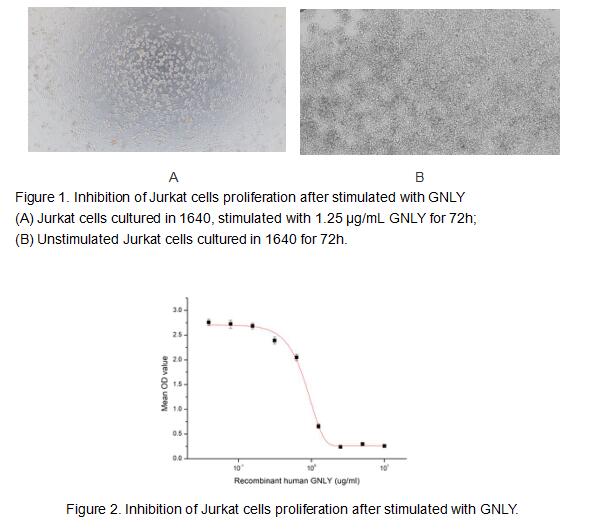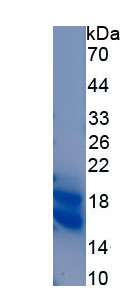Active Granulysin (GNLY) 

NKG5; LAG-2; TLA519; T-Lymphocyte Activation Gene 519
- UOM
- FOB US$ 204.00 US$ 510.00 US$ 1,020.00 US$ 3,060.00 US$ 7,650.00
- Quantity
Overview
Properties
- Product No.APB517Hu61
- Organism SpeciesHomo sapiens (Human) Same name, Different species.
- ApplicationsCell culture; Activity Assays.
Research use only - DownloadInstruction Manual
- CategoryTumor immunityInfection immunityImmune molecule
- Buffer FormulationPBS, pH7.4, containing 0.01% SKL, 5% Trehalose.
- Traits Freeze-dried powder, Purity > 80%
- Isoelectric Point9.4
Sign into your account
Share a new citation as an author
Upload your experimental result
Review

Contact us
Please fill in the blank.
Activity test

Granulysin (GNLY) is a member of the saposin-like protein (SAPLIP) family of membrane disrupting proteins. Granulysin is expressed in granules of natural killer and activated cytotoxic T cells. It exhibits cytolytic activity against intracellular or extracellular microbes and also tumors, either alone or in synergy with perforin. Human granulysin has structural similarity and 30 - 40% aa identity to granulysins and NK-lysins of other mammals such as bovine, porcine and canine; similar peptides in rodents have not been identified. The 15 kDa unglycosylated protein contains five helical domains; helix 2 and 3 contain 9 arginines and one cysteine critical for activity. The activity of GNLY is usually measured by a cell apoptosis assay using Jurkat cells. Jurkat cells were seeded into triplicate wells of 96-well plates at a density of 8,000 cells/well with 5% serum standard 1640 which contains various concentrations of recombinant human GM-CSF. After incubated for 3 days, cells were observed by inverted microscope and cell proliferation was measured by Cell Counting Kit-8 (CCK-8). Briefly, 10 µl of CCK-8 solution was added to each well of the plate, then the absorbance at 450 nm was measured using a microplate reader after incubating the plate for 2-4 hours at 37 ℃. Apoptosis of Jurkat cells after incubation with GNLY for 3 days observed by inverted microscope was shown in Figure 1. Cell viability was assessed by CCK-8 (Cell Counting Kit-8 ) assay after incubation with recombinant human GNLY for 3 days. The result was shown in Figure 2. It was obvious that GNLY significantly decreased cell viability of Jurkat cells. The ED50 is 0.84 ug/ml.
Usage
Reconstitute in 10mM PBS (pH7.4) to a concentration of 0.1-1.0 mg/mL. Do not vortex.
Storage
Avoid repeated freeze/thaw cycles. Store at 2-8°C for one month. Aliquot and store at -80°C for 12 months.
Stability
The thermal stability is described by the loss rate. The loss rate was determined by accelerated thermal degradation test, that is, incubate the protein at 37°C for 48h, and no obvious degradation and precipitation were observed. The loss rate is less than 5% within the expiration date under appropriate storage condition.
Increment services
-
 BCA Protein Quantification Kit
BCA Protein Quantification Kit
-
 Molecular Mass Marker for Protein
Molecular Mass Marker for Protein
-
 Monoclonal Antibody Customized Service
Monoclonal Antibody Customized Service
-
 Polyclonal Antibody Customized Service
Polyclonal Antibody Customized Service
-
 Protein Activity Test Experiment Service
Protein Activity Test Experiment Service
-
 Electrophoretic Mobility Shift Assay (EMSA) Experiment Service
Electrophoretic Mobility Shift Assay (EMSA) Experiment Service
-
 Buffer
Buffer
-
 Lentivirus Packaging Experiment Service
Lentivirus Packaging Experiment Service
-
 Adenovirus Packaging Experiment Service
Adenovirus Packaging Experiment Service
-
 Real Time PCR Experimental Service
Real Time PCR Experimental Service
-
 Spike RBD Protein (S-RBD)
Spike RBD Protein (S-RBD)
-
 Protein G
Protein G
-
 Protein A
Protein A
Citations
- Pretreatment Serum Level of 15-kDa Granulysin Might Have a Prognostic Value in Patients with Diffuse Large B Cell LymphomaKarger: 327255
- ДИНАМИЧЕСКИЕ ИЗМЕНЕНИЯ ГРАНУЛИЗИНА И КАТЕЛИЦИДИНА У ДЕТЕЙ И ПОДРОСТКОВ, БОЛЬНЫХ РАЗЛИЧНЫМИ ФОРМАМИ ТУБЕРКУЛЕЗА …







